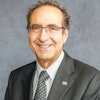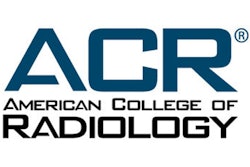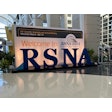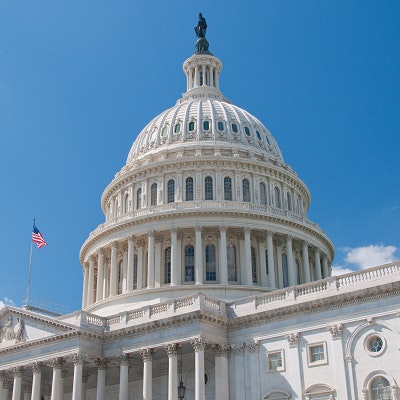
The U.S. Centers for Medicare and Medicaid Services (CMS) is the single largest payor for healthcare in the U.S., and as government moves to cut costs and improve value for the public healthcare dollar, the ripple effects are felt throughout radiology. Advocating for radiology during these times of change is a job for everyone in the field, not just radiologists.
On September 12, members of the Radiology Business Management Association (RBMA) visited the Washington, DC, offices of their senators and representatives for the association's annual Hill Day. Altogether, RBMA members had 40 individual meetings with elected officials and legislative staff in just one day. It was a lot of walking and waiting, but also one of our most important jobs as citizens in a democracy.
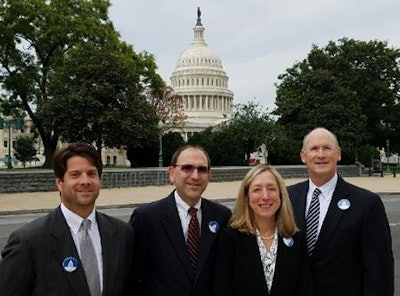 From left to right: RBMA Treasurer Michael Langenberg, President Thomas Dickerson, President-Elect Christie James, and Executive Director Robert Still.
From left to right: RBMA Treasurer Michael Langenberg, President Thomas Dickerson, President-Elect Christie James, and Executive Director Robert Still.Meeting with members of Congress and their staff, you get a sense of how many competing issues they must prioritize. Some of the issues we speak about aren't even registering with them, and some representatives know very little about what a radiologist does or "is" within the healthcare system. If physicians and other healthcare leaders want things to change in Washington at the governmental or policy level, they must choose to get involved. Otherwise, our subject matter will simply not get the attention it deserves.
Between us, we met with the staff of Sens. Tammy Duckworth (D-IL), Patrick Leahy (D-VT), Ed Markey (D-MA), Bernie Sanders (I-VT), and Elizabeth Warren (D-MA), as well as Reps. Mike Bishop (R-MI), Darin LaHood (R-IL), and Peter Roskam (R-IL). With the exception of the staff from Bishop's office (who, as a member of the House Ways and Means Committee, works on healthcare, Medicare, and Medicaid issues), all of our meetings were with legislative staff from our home states. Politics is local, and legislators overwhelmingly prefer to hear directly from constituents and businesses with an interest in the communities they represent.
Knowing how to approach legislators and present information to them in an effective manner takes experience. That is why it can be helpful to work as part of a larger group that can help you research issues and prepare clear arguments for legislators who are always short on time. The RBMA collaborates with the American College of Radiology (ACR) on advocacy, but it also has its own Federal Affairs Committee and resources to help its members speak up for radiology. This year, we expanded our efforts by launching our first Legislative Education and Regulatory News (LEARN) conference before our Hill Day. It further prepared our members to serve as true subject-matter experts for elected officials and congressional staff members working on health policy.
Healthcare reimbursement is incredibly complex, even for those of us who own or manage radiology businesses. When you get down to the micro level of how reimbursement is affected and the process a current procedural terminology (CPT) code goes through to get valued, it is mind-blowing.
The LEARN conference was an opportunity for RBMA participants to receive the latest information regarding reimbursement, payment methodologies, and regulatory challenges before they met with a legislator or his or her staff. Attendees heard from a variety of experts with different perspectives on the effects of healthcare policies. At breaks between speakers and roundtable discussion, meeting attendees also had the chance to network and learn from practice leaders with firsthand experience in how these issues are affecting practices and healthcare facilities across the country.
Understanding the big picture as well as the small details is crucial to effectively presenting radiology issues of concern to various legislative assistants and correspondents. In our meetings, we covered topics as diverse as preventive screening cuts, lack of funding for virtual colonoscopy, the lack of clarity regarding reimbursement rules for CT lung cancer screening, the impact of clinical decision support (CDS), and the rising costs associated with quality payment programs such as the Medicare-Based Incentive Payment System (MIPS) created by the Medicare Access and CHIP Reauthorization Act (MACRA).
We even got to talk about state-level issues, such as how Illinois taxes and malpractice costs are affecting our ability to recruit the best radiologists, and how the backlog of monies the state of Illinois owes providers is affecting radiology services in rural hospitals and communities. This year, we found that many legislators' offices were especially interested in hearing about examples of overregulation.
Educating staff members on our main talking points, as well as important details such as the mechanics of implementing CDS or the costs involved in credentialing, was inspiring for us and for the staff. We know that we are only one voice among many in politics, but if we can be at the forefront and remind legislators of our issues, eventually it will make a difference.
We are looking forward to our next opportunity to speak with our elected representatives and hope even more members of our field will join us next year. Through events like the LEARN conference and RBMA's Hill Day, getting started in advocating for radiology is really much easier than many people realize. When speaking up for continued access to quality imaging for our patients and communities, the hardest step is the first one. We invite you to visit rbma.org for help in taking that first step.
Thomas Dickerson is president of the RBMA Board of Directors and CEO of Clinical Radiologists based in Springfield, IL. Christie James is president-elect of the RBMA Board of Directors and operations manager for radiology revenue cycle management at Massachusetts General Physicians Organization in Charlestown, MA. Bob Still is executive director for the RBMA based in Fairfax, VA.
The comments and observations expressed herein are those of the authors and do not necessarily reflect the opinions of AuntMinnie.com.


